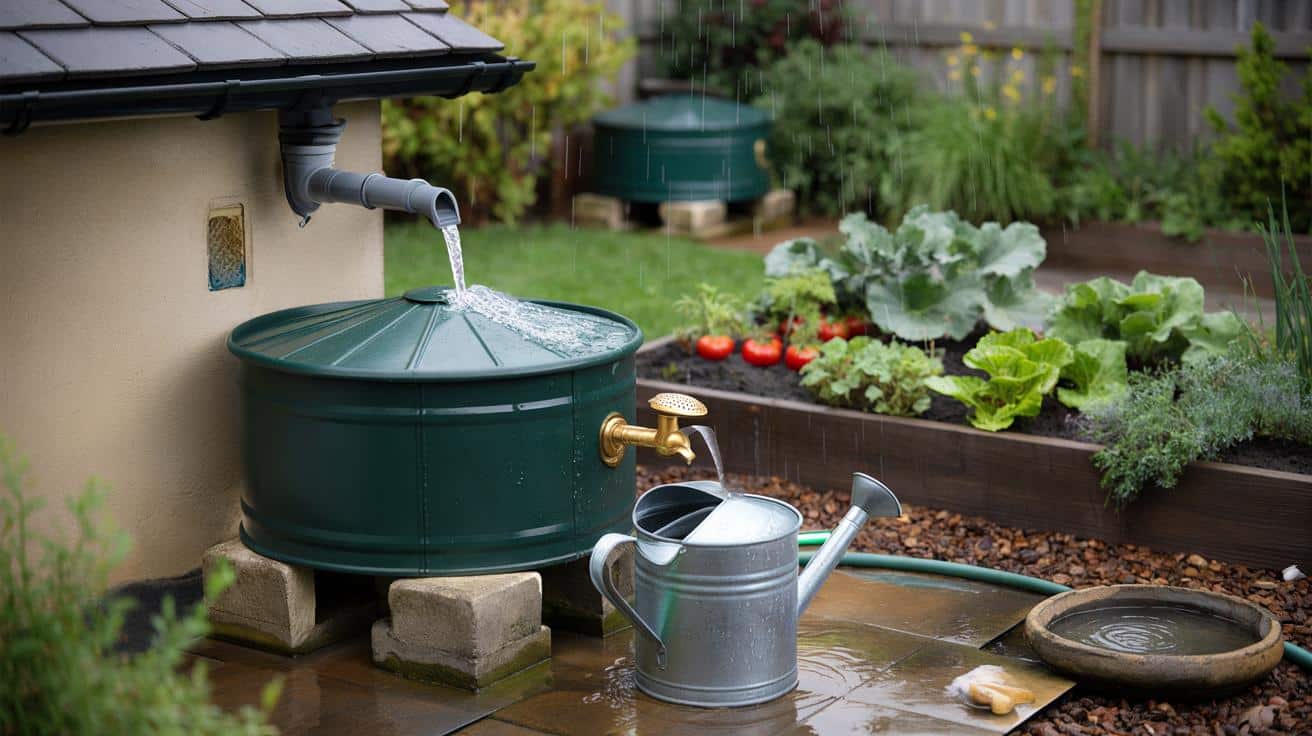Summers dry out. An old farmyard habit returns, promising relief for veg beds and household budgets.
Across Britain, households are turning their gutters into lifelines, channelling rain into barrels and tanks to keep crops alive when hosepipe bans bite. Set it up now, as autumn showers arrive, and your spring veg can start the season with a full reserve.
The gutter-to-butt revival
Farmyards once piped every downpour into barrels. The idea faded with cheap mains supply. Drier summers and rising tariffs now push gardeners back to a method that needs no electricity, little space and modest spend. A simple diverter on a downpipe can feed a 200–500 litre water butt within a few wet days.
This is not nostalgia. It is a practical hedge against restrictions and heatwaves. Rain-fed soil stays richer in life because it avoids chlorine. Beds bounce back after hot spells because water sits ready at the plot, not at the end of a tap that might be turned off by local rules.
One millimetre of rain on one square metre of roof yields roughly one litre of harvestable water.
Turn your roof into a reservoir
You need four elements: a downpipe diverter with a leaf screen, a covered tank, an overflow route, and a stand to add gravity. Choose a dark, closed container to cut algae. Place it in shade where possible. Keep the lid tight to block light and insects. Fit a fine mesh on any opening that must breathe.
What a typical roof can deliver
Use a simple formula: roof area (m²) × rainfall (mm) × efficiency. Most domestic systems reach 80–95% efficiency after a first-flush loss.
| Roof area (m²) | Rainfall (mm) | Estimated harvest (litres, 90% efficiency) |
|---|---|---|
| 50 | 5 | 225 |
| 50 | 10 | 450 |
| 80 | 5 | 360 |
| 100 | 20 | 1800 |
A single 5 mm shower across a 50 m² roof can deliver roughly 250 litres into your butt.
Watering without the tap
Armed with stored rain, you can irrigate at plant level and slash waste. Gravity does the work if the outlet sits above bed height. Connect a short hose, a soaker line, or fill watering cans. Keep flows slow. You want water at the root zone, not on leaves.
Cut losses before you water
- Mulch 5–8 cm deep around crops to slow evaporation and stabilise soil temperature.
- Water at dawn or late dusk to reduce loss to heat and wind.
- Shape shallow furrows alongside rows to guide water to roots.
- Bury porous clay pots (ollas) or perforated bottles between plants for deep, steady release.
- Group thirstier crops together to target irrigation where it matters.
These low-tech tweaks stretch every litre. Raised beds with compost hold moisture better than bare, compacted ground. Windbreaks curb drying gusts. Shade cloth over young brassicas or lettuces can halve midday stress during hot spells.
Maintenance you can do in minutes
Leaf litter blocks flow and degrades water quality. Brush gutters each month in autumn. Snap the diverter open and rinse the filter. Check seals, taps and hose barbs for drips. Drain and clean sludge from the butt base before winter. If freezing threatens, lower the water level or isolate the diverter to prevent splits.
Do not drink roof-harvested rain. Keep it for soil-level irrigation and tool cleaning.
Savings, biodiversity and payback
Gardeners report saving several hundred litres per month in peak growing season with only one or two butts. Many off-the-shelf kits cost £60–£120. A season or two of reduced mains use often covers the outlay, depending on your tariff and garden size. More importantly, you water when restrictions would normally stop you.
Rainwater carries no residual chlorine. Soil microbes, mycorrhizal fungi and earthworms respond well to that. Beds fed with rain often develop a richer crumb structure and improved infiltration. Birds, bees and hedgehogs visit more often when a shallow dish stands nearby. Add pebbles or a ramp so small creatures can climb out safely.
How to install, step by step
Risk control and good practice
Keep stored water dark and cool to limit algae and bacterial growth. Avoid creating sprays or fine mists with roof runoff, and prefer direct soil watering. Do not use roof-collected water on edible leaves ready for raw eating. Wash hands after maintenance. If you use a pressure sprayer for pesticides or foliar feed, fill it with tap water instead.
Check local rules if you plan large tanks or visible pipework. Small domestic butts rarely need permission, but siting and overflow routes still matter. Place weight on sound ground. A full 200 litre butt weighs about 200 kg, plus the container.
Autumn is the sweet spot
Autumn showers offer a free first fill while beds still need moisture for late brassicas and overwintering crops. Fit new filters before leaf-fall to intercept debris. Set a schedule: a five-minute check after heavy rain, a monthly clean during the leaf season, and a pre-spring inspection of seals and taps.
Plan capacity for next summer
Use past rainfall data for your area as a guide. Multiply average monthly millimetres by your roof area and an efficiency of 0.9 to estimate litres. Match that to crop demand. Tomatoes, courgettes and beans drink more; onions and herbs drink less. Two linked 200 litre butts at the shed and greenhouse often balance supply for a small plot.
Think in weeks of supply, not days: aim for 400–600 litres of storage per 10 m² of thirsty beds.
Beyond the barrel: upgrades that pay their way
Greywater can complement rain if you choose plant-safe soaps and filter out lint and fats. Direct it to ornamental beds, not salads. A small, low-head solar pump can lift water uphill to a header tank if your plot is flat. Drip lines with pressure-compensating emitters run well from a raised tank, but keep runs short and flush them each month.
Combine water capture with soil care. Add compost to raise organic matter and improve moisture retention. Sow drought-tolerant varieties of French beans and kale for resilience. Space plants to reduce competition during dry spells. A simple notebook log of rainfall, tank levels and crop needs helps you fine-tune storage for the next season.








